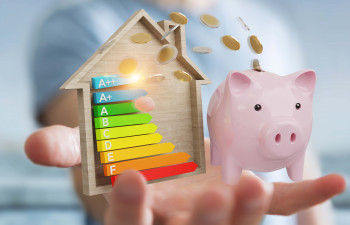Decarbonisation and net zero are terms you will hear a lot in the construction industry, especially in the sphere of heating, ventilation and air conditioning (HVAC). That’s because HVAC has a particularly prominent position in the decarbonisation of buildings. In this article we explore the importance of HVAC in achieving net zero, how we decarbonise buildings, and what tools can help you make sustainable choices.
Why is HVAC key to net zero?
Decarbonisation is all about reducing the amount of carbon dioxide (CO2), and other greenhouse gas (GHG) emissions, such as methane (Ch4), nitrous oxide (N2O) and fluorinated gases (F gases), that are produced and released into the atmosphere. Net zero is the goal, where we bring those greenhouse emissions as close to zero as possible, with any remaining emissions re-absorbed from the atmosphere by other means, such as oceans or forests.
When we talk about decarbonising buildings, it is the process of reducing the CO2 and GHG emissions a building produces. This means improving the building’s energy efficiency to reduce its power consumption, switching to decarbonised energy, replacing inefficient HVAC products using fossil fuels and high Global Warming Potential (GWP) refrigerants, and reducing embedded carbon emissions in building products and materials.
HVAC is at the very centre of decarbonisation for three reasons:
- Heating and cooling buildings uses an enormous amount of energy. In the European Union for example around 50% of a building’s energy consumption goes on heating and air conditioning.
- HVAC systems have traditionally relied on harmful fossil fuels, or fluorinated gases to operate.
- HVAC is everywhere! HVAC and refrigeration transcends buildings and processes used in all aspects of our daily lives, from where we live, work and play, to the products we use and even food we consume.
Therefore HVAC manufacturers, specifiers, designers, installers and buyers all have a huge role to play in decarbonising buildings.
What is a decarbonised building?
The holy grail is the zero carbon building, also known as the Zero Emission Building (ZEB). A zero carbon building is a highly energy efficient building that requires only a small amount of energy to operate. The energy it does use is zero carbon, and the building is made from materials and products with low to zero embedded carbon emissions. Where carbon is produced through the building’s operation or materials, high-quality carbon offsetting can be used to offset annual carbon emissions.
Buildings can be zero carbon in a number of ways, examples include:
- 100% electrification, using zero carbon energy from the grid
- Constructing buildings to Passivhaus standards, using ether zero carbon energy from the grid or onsite/offsite renewables
- Renovating existing buildings to a high efficiency standard, using ether zero carbon energy from the grid, onsite/offsite renewables, or a mix of both.
The widescale adoption of zero emission buildings will not happen overnight. Indeed the readiness of infrastructure for zero carbon energy varies wildly from country to country. Our World In Data shows that globally 39% of electricity came from low-carbon sources in 2020, with Paraguay, Iceland, Sweden and Uruguay producing over 95% of their electricity from such sources in 2021. At the other end of the spectrum, Saudi Arabia produced just 0.23% of electricity from renewables in the same year. Countries such as India (21.95%), Australia (29.13%), United States (39.49%), Germany (49.16%) and the United Kingdom (55.05%) still have some way to go to catch up with countries such as France (87.85%) and Canada (82.13%). For some countries the challenges of decarbonisation are huge, while others will travel the road to net zero more smoothly. In the meantime, we all need to start taking steps to decarbonise.
How do we decarbonise buildings?
1) Uptake of low carbon technologies
We need a sustained uptake of proven low-carbon technologies, not just in the new-build sector, but in existing properties also. The electrification of heating, hot water and cooking appliances will go hand-in-hand with the phase out of fossil fuels and high GWP refrigerants. HVAC manufacturers are already streets ahead of other industries when it comes to decarbonising products and increasing energy efficiency. The technology is available but it’s up to specifiers, designers and buyers to choose sustainable systems.
2) Energy efficiency
One of the first steps in decarbonising buildings is improving energy efficiency. In existing properties the building envelope (roof, insulation, walls and doors) will usually need upgrading to reduce energy demands for heating and cooling. Then there are a range of appliances that can be upgraded to more efficient models, from the aforementioned HVAC and hot water systems, to white goods, lighting, entertainment and computing.
3) Switch to renewable / decarbonised energy
One of the largest hurdles to net zero is decarbonising the energy we use. The long term goal is to completely decarbonise the grid via renewables, nuclear, hydrogen and sustainable bio fuels. Until then, onsite renewable energy production by solar, wind or combined heat and power (CHP), offers opportunities for zero carbon energy.
4) Approaching buildings holistically
Professionals will have to understand the bigger picture, and not just the aspects traditionally associated to their role. For example, the perfectly designed low-temperature, heat pump system, will be ineffective, inefficient and expensive to run if the building is poorly insulated. Likewise, improved insulation to the building envelope may result in the need for enhanced ventilation to avoid poor indoor air quality from condensation and mould. To create truly energy efficient buildings, everything from the foundations up should be considered.
5) Embedded carbon
Embedded carbon in materials used for both the manufacture of products and construction of buildings has to be reduced. For example companies are now switching to green steel (made without using coal by renewable electricity and hydrogen) or low carbon concrete products to help lower emissions. Low carbon manufacturing processes and a product or material’s transport emissions should also be considered.
6) Education and training
Buyers and end users need to be educated about the benefits and practicalities of decarbonisation. When it comes to industry professionals, specifiers, system designers and installers have to understand the intricacies of designing and using energy efficient systems utilising low carbon technologies. Installers will also need to be competent in installing, maintaining and fixing decarbonised products.
7) Legislation - Minimum Energy Performance Standards (MEPS)
Governments are introducing legislation and regulations that implement change. The mandatory introduction MEPs for both new-build and retrofit applications is an essential step for decarbonisation, as is adequate policing of the new regulations. Many governments are initially introducing MEPs in the easier to implement new-build sector, however the real carbon savings will be found in upgrading existing buildings. Effective legislation for retrofit will need to be inclusive and able to be practically applied to all properties.
8) Financing, grants and initiatives
Access to finance, grants and initiatives will be vital to ensure existing buildings are suitable for low carbon technologies and encourage the jump to sustainable systems. This will also help reduce the perceived risk of using new technologies, with potentially high up-front costs.
How does certification aid decarbonisation and net zero?
Products that can prove their energy efficiency and low global warming potential will be in high demand as we seek to future proof buildings on the path to net zero. Those products that have had their energy performance independently verified, and hold certification such as the internationally recognised Eurovent Certified Performance (ECP) mark, will stand out from the competition, and meet MEPs, regulations and codes.
Certification provides specifiers and designers with access to accurate performance data, which allows them to easily compare products. Certified products are evaluated according to the same criteria, and the results are expressed in the same unit of measurement, regardless of the country where the products are manufactured or marketed. Specifiers, designers and installers can also trust the product will perform as expected in its chosen application, as manufacturers energy efficiency claims have been verified and scientifically tested by an expert, independent, third-party.
Check out our certified product directory







